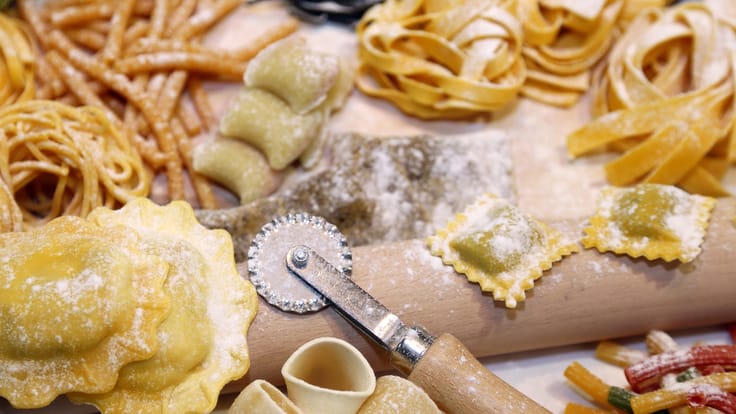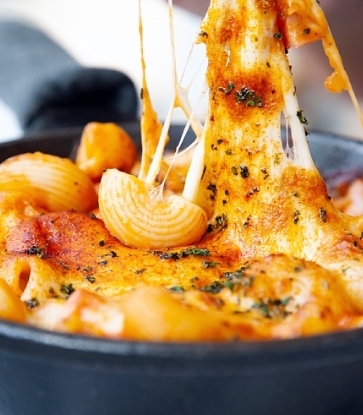
A sfoglina is a woman who makes fresh egg pasta by hand using the traditional tools — a wooden pin and board. It’s named for the sheets of pasta rolled out, called sfoglia. Historically, a sfoglina would make pasta for Sunday dinners with the family. Today, many of these artisans work in restaurants to share the importance of the Italian craft.
When Capotondo was working in restaurants making fresh egg pasta, she noticed that her techniques fascinated guests and she decided to share her knowledge by teaching. Three years ago, Capotondo arrived in Washington, D.C., for the first time to work with Fabio Trabocchi to open Bib Gourmand establishment Sfoglina in Van Ness.
This year, Capotondo is offering regular classes at Sfoglina where visitors can learn the basic techniques of rolling and shaping egg pasta, or get more adventurous with classes covering semolina pasta, gnocchi, coloured or flavoured doughs, and even pasta made with flowers and herbs in the dough, which results in a mosaic of colour in each strand.
I don’t want to buy an expensive pasta machine but I love fresh pasta. How can I make consistent batches of pasta by hand? Is there a way to make more while I’m at it each time and store the excess?
The first thing to know is that pasta made by hand is structurally different than pasta made by machine, such as an electric or manual roller or extruder. When egg dough is pressed through a roller, it flattens quickly and is completely smooth. When egg dough is rolled out by hand on a wooden board with a wooden rolling pin, it gradually thins, increases in size and develops a coarseness from contact with the wood. This allows it to absorb sauces better and results in a superior texture.
The Equipment
Because sfoglia must be rolled out into extremely thin and even sheets, using a completely flat rolling pin and board is key. Wooden items like these can warp, so check to make sure there are no gaps between the pin and the rolling surface before you begin. The rolling pin must be at least 30 to 40 inches (76 to 102cm) long, as the sheets become very large when rolled. I recommend sites like Fante's, Romagnoli Pasta Tools, Vermont Rolling Pins and Italy-based company Taglia Pasta to find wooden pins and boards as well as other accessories like stamps, cutters and more.

A sfoglina traditionally works with egg dough, made with just flour and eggs. This kind of pasta is common in central Italy. Because there are just two ingredients, it's important that they are of the best quality. If you can find it, Italian “00” flour is best. The consistency is like a fine powder, which makes it easier to roll out and shape the dough. Once you master the technique, you can play with different flour types, such as using half semolina flour and half “00” flour if you prefer a pasta with a tougher texture. Use large, fresh eggs with bright yellow yolks. This will provide the hue and flavour for the dough. You can use any type of eggs — chicken, quail, duck — as long as you follow the proper ratio.
The Proper Egg-to-Flour Ratio
As a general rule of thumb, use one large egg for every 100g of flour. If you want to be more precise (or use a non-standard size of egg), you can measure 60g of egg (without the shell) for every 100g of flour. For a manageable batch of dough, use three eggs (180g) and 300g of flour.
Making The Pasta Dough
Start by putting a mound of flour in the centre of the board, reserving a small portion to add as you roll to keep the dough from sticking. This way, you won't end up adding more flour than the dough requires as you dust your surfaces while rolling.
Use your hands to shape the flour into a volcano with a well in the centre — or, as the Italians call it, fontana, which means fountain. Crack the eggs into the centre of the well and beat them with a fork. Once combined, use the fork to begin incorporating flour from the inner walls of the well, a bit at a time. Be careful not to break the well or you’ll have a flood of egg on the board.
Once the flour has been completely incorporated into the eggs, start to fold and knead the dough using a bench scraper (to keep your hands from getting sticky). After a few minutes, the dough will be smooth enough to use your hands. To knead the dough, take the ball and fold it in half towards you, then press it with the heel of your palm away from you. Rotate the ball a quarter turn and repeat. You always want to keep the fold on the top side of the dough so that the underside will eventually become perfectly smooth. Use the additional flour as needed if the dough sticks to the board or your hands. Do this for about 10 to 15 minutes, until it feels elastic and is no longer sticky. It should bounce back slowly when you press it. In Italy, we say the texture should be like when you touch your earlobe.
Cover the dough with plastic wrap and let it rest at room temperature for at least 15 minutes or up to an hour. Clean your board with the bench scraper.

Start by placing the rolling pin in the centre of the ball of dough, pressing down and pushing it away from you, to thin out the dough. Stop just short of the end of the dough—don't roll over it onto the board or you'll flatten the edge too much. After each roll, rotate the dough a quarter turn and repeat, starting in the centre. The secret to getting a perfect circle is to rotate often. When the dough gets too big to manage, you can let some of it drape over the edge of the board in front of you. Throughout this process, dust the dough with flour to prevent sticking. If the dough does stick, add a pinch more flour and flip the dough.
The second technique is a bit more complex. Make circles with your hands on the rolling pin, sliding them away from and back toward each other as you push the rolling pin away from you and back toward you. Starting with your hands together in the centre of the rolling pin, push away from you as you slide your hands toward the ends of the pin. Then, pull the pin back toward you as you slide your hands back toward the centre of the pin. The trick is to keep your wrists low and your fingers cupped over the pin so that the rolling pin is rolling with just your palms, not your entire hand. Again, don’t roll over the edge of the dough. It’s a lot to think about at first, but the more you do it, the more natural and fluid it should become. Continue this technique and alternate it with the first.
After the section you're working has thinned out, you’ll need to rotate the dough. Place the pin at the far edge of the dough and roll the sfoglia toward you, around the rolling pin. Turn the pin 90 degrees and unroll the sfoglia onto the board, draping half of it off the board again. Then use the first and second techniques to thin it out.
Finally, with the third technique, you’ll use the rolling pin to stretch the dough. Roll about three-quarters of the sfoglia on the board around the rolling pin. Then place the pin on the edge of the board closest to you, press it away from you gently, then pull it back a little, then push it away again, stretching the dough as you unroll it. Then continue the first and second techniques.
In order to maintain even moisture, you should flip the dough occasionally. To do this, roll half of the sheet around the rolling pin, pick it up and unroll it upside down.
Repeat these three techniques, and rotate or flip the dough as needed, until it is thin, even and smooth. Keeping a portion of the dough hanging off the edge of the board will let gravity assist in this process. It is ready when you can see the grain of the wooden board through the pasta. In Italy, we say you can read a newspaper through the sfoglia.

Cutting And Assembling Pasta Shapes
With a beautiful sheet of fresh pasta, you can make a variety of shapes, from tortellini and ravioli to tagliatelle and pappardelle. For stuffed pasta like tortelloni, tortellini, panzotti and ravioli, use the sheet immediately, as moisture is key. For unstuffed pasta like tagliatelle, pappardelle, garganelli and farfalline, let the sheet dry a bit before cutting.
To make tortelloni and tortellini, cut squares of your desired size and use a piping bag to pipe small amounts of filling into the center. Fold the square opposite corner to opposite corner and press firmly to seal the edges. The moisture from the dough should be enough to seal the shape, so you shouldn't need an egg wash. You should have a triangle shape. Bring the two ends together and pinch them to seal.
To make tagliatelle and pappardelle, dust the entire sheet heavily with rice flour or semolina flour. Roll up each end of the sheet horizontally and meet in the middle, like a scroll. Using a knife, cut strips of your desired thickness all the way across the roll. Then, slide the flat side of the knife under the cut strips, with the dull edge toward you. Bring the dull edge to the center of the roll (where the two rolled sides met), rotate the knife and lift, letting the strips unfurl.
Storage and Cooking Fresh Pasta
Stuffed pastas can be frozen immediately after they are made and then cooked from frozen. Unstuffed pasta can also be frozen immediately and cooked from frozen, or you can let it dry for a week and then store in airtight containers for a month. For long pasta like tagliatelle or pappardelle, twirl the strands into nests — large, loose nests for drying and small, tight nests for freezing.
Be sure to keep in mind that whether you’re cooking your pasta immediately or after it has been dried or frozen, it will cook much faster than store-bought dried pasta. Cook in salted boiling water until it floats to the top, about five minutes.

















